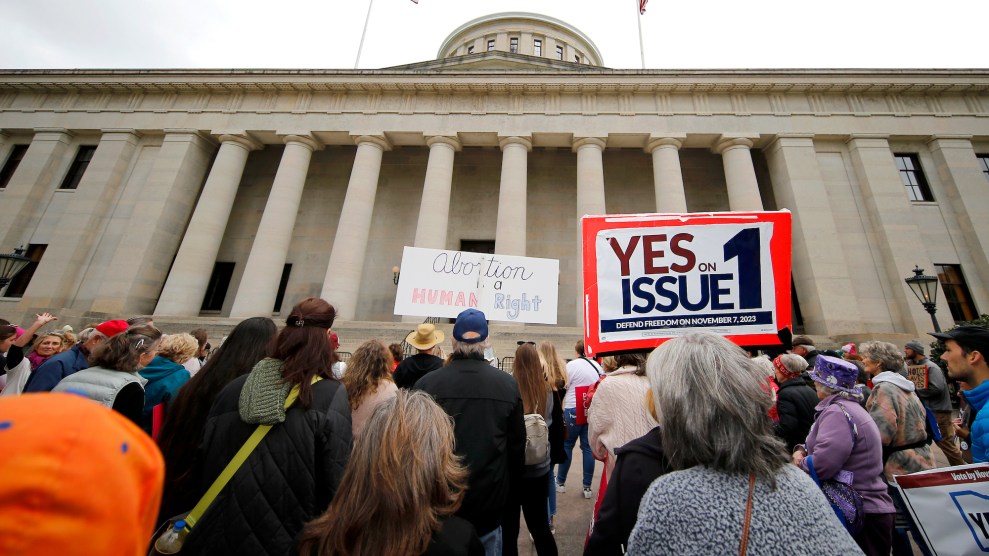
Republican vice presidential nominee Sen. JD Vance (R-Ohio) and Democratic vice presidential nominee Minnesota Gov. Tim WalzJulia Demaree Nikhinson/AP
GOP vice presidential nominee JD Vance has a refrain he loves to repeat when he’s questioned about his draconian anti-abortion positions and former President Donald Trump’s plans for reproductive rights: Leave it to the states.
That’s essentially what he said when he faced off against Minnesota Gov. Tim Walz at the vice presidential debate Tuesday night when moderator Norah O’Donnell asked if he would create a federal pregnancy monitoring agency. Vance said he would not create such an agency, but then continued: “The proper way to handle this, as messy as democracy sometimes is, is to let voters make these decisions, let the individual states make their abortion policy.”
In a way, Vance has a point. In every state that has put the question of abortion rights to voters since 2022, when the Supreme Court overturned Roe v. Wade, the measure has passed with flying colors. And that includes Vance’s home state of Ohio, as my colleague Madison Pauly previously reported.
But there’s a problem. The GOP keeps trying to sabotage abortion rights ballot measures before they even get to voters. They did so in Ohio last year, by instituting a special election in August to try to raise the threshold to amend the state constitution, as we wrote at the time:
Republicans in the Ohio statehouse tried to change the rules before their constituents get a chance to vote for abortion rights. In May, they passed a resolution forcing a statewide vote on whether to make it harder to pass any future amendments. They claimed their effort, which was largely funded by far-right Illinois billionaire Richard Uihlein, was intended to block interference from “out-of-state special interests.” But they specifically made sure the vote on their proposal took place before the abortion-rights vote in November. To that end, they approved a bill this spring reinstating August special elections—which they had just eliminated on the theory that summer elections were too low turnout to be worth the cost. (“These unnecessary ‘off-cycle’ elections aren’t good for taxpayers, election officials or the civic health of our state. It’s time for them to go!” LaRose, who is running for Senate, had previously argued.)
The effort—which Vance backed—was not successful. A surprising number of Ohioans turned out and defeated the attempt to stymie the abortion rights ballot measure, which ultimately went before voters in November and passed with a wide margin. Now, abortion access is protected in Ohio until the point of fetal viability—usually around the time of 24-weeks gestation. The law also allows for later-term abortions to protect the pregnant person’s life and health.
The Ohio GOP is not alone in its efforts to undermine ballot measures. As Madison wrote, Missouri Republicans have been unsuccessfully trying to do the same thing to their state’s forthcoming abortion ballot measure, as have the Republicans of South Dakota. In Florida, Gov. Ron DeSantis and his cronies have recently tried to tank their state’s upcoming abortion rights vote, including by potentially breaking the law and reportedly sending police to abortion rights supporters’ homes. As I recently reported:
The state’s health department debuted a webpage spreading misinformation about Amendment 4, a ballot measure appearing in November seeking to override the state’s six-week abortion ban that the Florida Supreme Court approved in April. If it receives the required 60 percent of votes to pass, the amendment would guarantee the right to abortion before the point of so-called fetal viability, which is generally understood to be around 24 weeks gestation. But the state’s new webpage—which DeSantis has since defended as a “public service announcement”—attacks the initiative with a litany of false claims, including that it “threatens women’s safety,” would “eliminate parental consent” for minors seeking abortions, and could “lead to unregulated and unsafe abortions” by allowing people without healthcare expertise to perform the procedure.
Meanwhile, in Kansas, where voters have enshrined abortion rights just two months after Dobbs, Republicans have continually tried to ban the procedure—including by overruling Gov. Laura Kelly’s vetoes of four anti-abortion measures.
If, as Vance suggests, abortion policy should be determined by a democratic process, it would be legal nationwide, which polling shows is the preference of the majority of Americans. But short of that, as Vance says, reproductive rights will be left to the states. And the GOP in those states shows no interest in letting voters have their say without a fight.
















